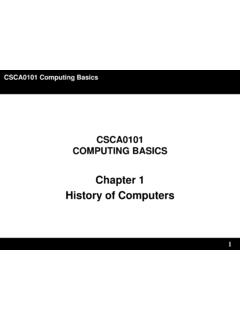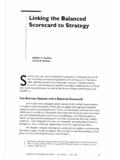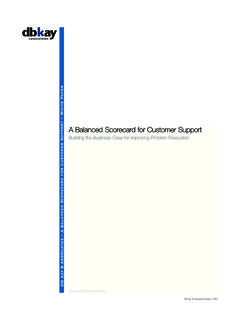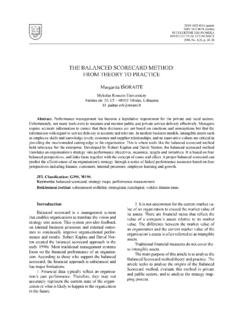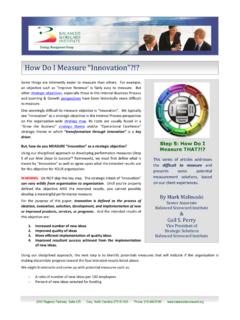Transcription of COMMENTARY Transforming the Balanced …
1 2001 American Accounting AssociationAccounting HorizonsVol. 15 No. 2 June 2001pp. 147 160 COMMENTARYT ransforming the Balanced Scorecardfrom performance Measurement toStrategic Management: Part IIRobert S. Kaplan and David P. NortonRobert S. Kaplan is a Professor at Harvard University and David is founder and president of the Balanced scorecard Collabo-rative in Lincoln, a previous paper (Kaplan and Norton 2001b), we described the role for strategymaps and Balanced Scorecards to develop performance objectives and measures linkedto strategy. With this paper, we show how organizations use their scorecards to alignkey management processes and systems to the strategy. We also discuss the relation-ship of the Balanced scorecard (BSC) to other financial and cost measurement initia-tives, such as shareholder value metrics and activity-based costing, and quality pro-grams.
2 We conclude with suggestions about opportunities for additional research onmeasurement and management FIVE PRINCIPLES OF A STRATEGY-FOCUSED ORGANIZATIONWhen asked to describe how the Balanced scorecard helped them achieve break-through performance , executives of adopting organizations continually referred to twowords: alignment and focus (Kaplan and Norton 2001a, Chapter 1). Although each or-ganization achieved strategic alignment and focus in different ways, at different pacesand in different sequences, each eventually used a common set of five principles, whichwe refer to as the Principles of a Strategy-Focused Organization, portrayed in Figure #1: Translate the Strategy to Operational TermsOrganizations translate their strategy into the logical architecture of a strategymap and Balanced scorecard to specify in detail the critical elements for their growthstrategies (Kaplan and Norton 2001b).
3 These create a common and understandablepoint of reference for all organizational units and #2: Align the Organization to the StrategyOrganizations consist of numerous sectors, business units, and specialized depart-ments, each with its own operations and often its own strategy. Functional departments,such as finance, manufacturing, marketing, sales, engineering, and purchasing, have148 Accounting Horizons/June 2001 FIGURE 1 The Principles of a Strategy-Focused OrganizationSource: Kaplan and Norton (2001a) Transforming the Balanced scorecard from performance Measurement to Strategic Management: Part II149their own bodies of knowledge, language, and culture. Functional silos arise and be-come a major barrier to strategy implementation since most organizations have greatdifficulty communicating and coordinating across these specialty functions.
4 For organi-zational performance to be more than the sum of its parts, individual strategies must belinked and integrated. The corporate role defines the linkages expected to create syn-ergy and ensures that the linkages actually 2 shows the linkages at the Mobil North American Marketing and Refiningdivision (NAM&R). The high-level strategic themes in #1 guide the development of theBalanced Scorecards in the business units in #2, which are either geographic regions orproduct lines, such as lubricants. Each unit formulates a strategy appropriate for itstarget market in light of the specific circumstances it faces competitors, market op-portunities, and critical processes but that is consistent with the themes and priori-ties of NAM&R. The measures at the individual business-unit levels do not have to addto a divisional measure, unlike financial measures that aggregate easily from sub-unitsto departments to higher organizational levels.
5 The business-unit managers choose lo-cal measures that influence but are not necessarily identical to the divisional aligning the business units, strategy-focused organizations must align theirstaff functions and shared service units, such as human resources, information technol-ogy, purchasing, environmental, and finance as in #3 of Figure 2. Often this alignmentis accomplished with service agreements between each functional department and thebusiness units. Management and cost accounting textbooks describe how to assign thecosts of support departments to production departments and selling units. The scorecardapproach is much more comprehensive. In addition to contracting on price or cost, thestaff functions and the line business units agree to the menu of services to be provided,including their functionality, quality level, response time, and cost.
6 This service agree-ment becomes the basis of the Balanced scorecard constructed by the functional de-partment. The department s customers are the internal business units, the value propo-sition is defined by the negotiated service agreement, and the financial objectives arederived from the negotiated budget for the department. Next, the department identi-fies the internal process and learning and growth objectives that drive its customer andfinancial this process is complete, all the organizational units line business units andstaff functions have well-defined strategies that are articulated and measured by Bal-anced Scorecards and strategy maps. Because the local strategies are integrated, theyreinforce each other. This alignment allows corporate-level synergies to emerge in whichthe whole exceeds the sum of the individual can also be established across corporate boundaries, as in #4 of Exhibit companies constructed Balanced Scorecards to define their relationships withkey suppliers, customers, outsourcing vendors, and joint ventures.
7 Companies use suchscorecards with external parties to be explicit about (1) the objectives of the relation-ship, and (2) how to measure the contribution and performance of each party to therelationship in ways other than just price or cost. Sometimes, particularly in govern-mental settings, scorecards are defined for high-level themes, such as salmon recoveryin Washington State and economic development in the City of Charlotte, that encom-pass multiple departments and government agencies. No one department or agencyhas complete jurisdiction or ability to influence the desired outcomes. The scorecard forthe high-level theme provides the mechanism that engages managers from multiple150 Accounting Horizons/June 2001 FIGURE 2 Aligning the Organization to Its StrategySource: Kaplan and Norton (2001a) Transforming the Balanced scorecard from performance Measurement to Strategic Management: Part II151departments and agencies to discuss how they can contribute to achieving high-levelstrategic #3: Make Strategy Everyone s Everyday JobThe CEOs and senior leadership teams of adopting organizations understood thatthey could not implement the new strategy by themselves.
8 They wanted contributions actions and ideas from everyone in the organization. The third principle of strategy-focused organizations requires that all employees understand the strategy and conducttheir day-to-day business in ways that contribute to the success of that strategy. This isnot top-down direction. This is top-down communication. Senior managers understandthat individuals far from corporate and regional headquarters can create considerablevalue by finding new and improved ways of doing start this process by using the Balanced scorecard to communicate andeducate the organization about the new strategy. Some observers are skeptical aboutcommunicating strategy to the entire organization, feeling that valuable informationwould be leaked to competitors.
9 Mobil s Brian Baker s response was:Knowing our strategy will do them little good unless they can execute it. On the otherhand, we have no chance of executing our strategy unless our people know it. It s achance we ll have to can educate the employees about surprisingly sophisticated businessconcepts. To understand the scorecard , employees learn about customer segmentation,variable contribution margin, and database marketing. Instead of assuming that theworkforce is incapable of understanding these ideas, managers make concerted effortsto educate employees at all levels of the organization about key strategic Drucker (1954) introduced management-by-objectives (MBO) nearly 50 yearsago. But Drucker s excellent concept was implemented poorly in practice, leading toMBO in most organizations focusing on a myriad of local measures and initiatives notlinked to high-level organizational objectives or coordinated with each other.
10 The Bal-anced scorecard enables personal objective setting to be integrated across the organiza-tion and linked to high-level strategic communicate their strategy and scorecard holistically. Instead of cas-cading objectives through the chain of command, as is normally done, they communi-cate the complete strategy down to individual employees. Individuals and departmentsat lower levels are challenged to develop their own objectives in light of the broaderpriorities; in some cases, personal scorecards are used to set personal objectives. Manypleasant surprises result from this process as individuals find new ways to do their jobsand identify areas outside their normal responsibilities to which they can , most organizations link incentive compensation to the Balanced scorecard ,typically after managing with the scorecard for a year.


